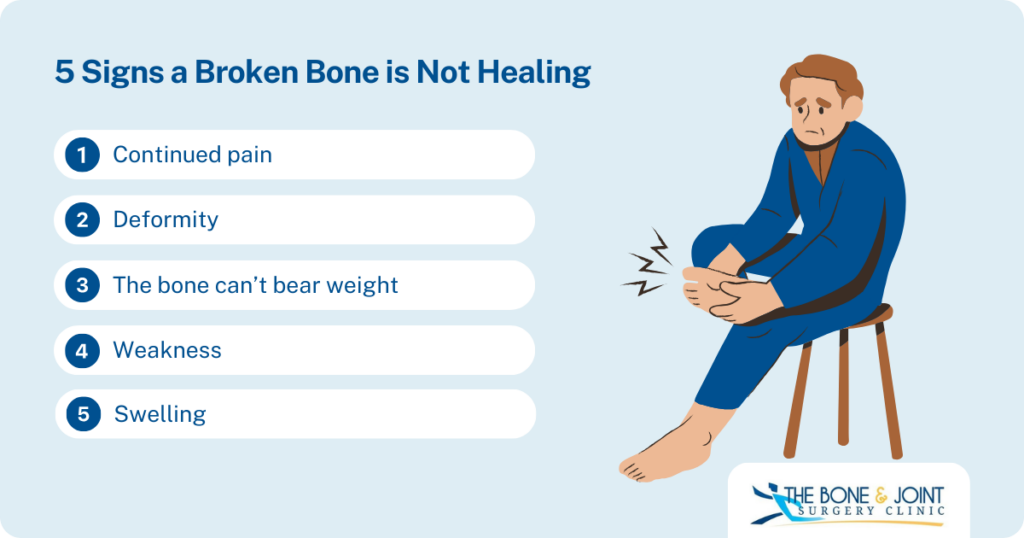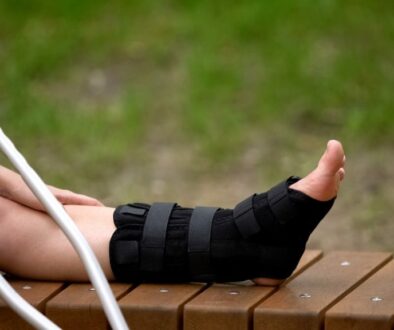Your Stalled Recovery: 5 Signs a Broken Bone Is Not Healing
For many patients, it can start with the simplest motion: Stepping off a curb the wrong way, a fall down the steps, a slip on the pickleball court. But the solution also seems simple: A cast and weeks of waiting while your body’s natural healing process occurs.
But it’s been eight weeks and the pain persists that has gradually gotten so annoying that the aggravation spills into other aspects of your life.
If it’s been that long and you’re still having pain at the site, this is one of the signs a broken bone is not healing.
Thankfully, with the help of modern medicine, most broken bones do heal within time. Granted, the length of time varies depending upon the extent of the break, which bone was broken, and whether or not surgery was needed. Most simple fractures will heal within six to eight weeks. However, more severe breaks to bones like your femur (thigh bone) can take several months to heal.
With all these variables, how can you be sure your broken bone is healing?
That’s where our experienced, board-certified orthopedic doctors in Raleigh step in.
We’re proud to be one of the few independent orthopedic practices in Wake County. Because our surgeons are connected to several different local surgery centers, you have a choice of where you can receive inpatient or outpatient treatment. In addition, we also have physical therapy professionals on site at our locations so that you don’t have to go elsewhere for these services. The Raleigh Bone and Joint Surgery Clinic is the premier provider in the region. To experience firsthand our compassionate care paired with state-of-the-art technology, just contact us and speak with your primary care provider for a referral.
How Can You Tell if a Broken Bone is Not Healing?
Every fracture is slightly different. More complex fractures may require surgery while a simple cast is needed for others. We know it’s vital to constantly monitor your progress to ensure the healing process takes place. If not, we can intervene to ensure you will not have more serious issues later. This is one reason why it’s so important that you know the signs a broken bone is not healing.”

We’ll take a closer look at five main signs a broken bone is not healing, what occurs as part of the healing process and what happens if a broken bone does not heal.
1. Continued Pain
A continued, aching pain–often felt deep within the bone–is one of the most obvious signs a broken bone is not healing. While it is natural to expect pain in the broken bone, this pain should gradually get better. This is why we always want to know your pain or discomfort level throughout the treatment process.
Pain that gets worse or fails to subside should be addressed by one of our orthopedic surgeons in Raleigh.
2. Deformity
Was your bone straight, but is now bent? That is one of the first indicators that it may not be healing the way it should.
3. The Bone Can’t Bear Weight
If healing is progressing as it should, the bone should eventually be able to bear weight. If the bone involved isn’t a weight-bearing bone, be on the lookout for extremely limited movement that does not improve despite physical therapy and following your doctor’s instructions.
4. Weakness
As we mentioned earlier, weakness and pain are typical after a fracture, but they should gradually improve. If the weakness continues, we’ll need to evaluate you to get to the heart of the issue.
5. Swelling
When you break a bone, you may have swelling at the site. However, this swelling should eventually subside. Constant swelling, coupled with pain, are signs a broken bone is not healing.
What Happens If My Broken Bone Doesn’t Heal?
If your bone is not healing, then you may need surgery–particularly if this is a complex fracture or an extensive break. In certain cases, you may need a bone graft to help new bone grow so that the healing process can occur.
What Helps a Broken Bone Heal Faster? Bone Stimulation
There are a few techniques for bone stimulation. One uses a low-intensity ultrasound pulse, while another uses a very low level electrical current.
The low electrical stimulation model works by “tricking” your body into believing that you have been recently injured.
As a result, it sends proteins to the site to begin the repair process.
By contrast, an ultrasonic bone stimulator helps improve calcium in the bone in addition to sending healing proteins.
What Is the Longest Time for a Broken Bone to Heal?
As we mentioned earlier, this depends upon the type of bone, the kind of fracture, and whether or not surgery was involved. Some patients with femur fractures may not experience complete healing for six months. The tibia also takes longer to heal. The tibia is the larger bone in your lower leg.
In addition, fractures to the scaphoid bone frequently take a long time to heal—some patients may have to wear a cast for up to six months. The scaphoid bone is one of the tiny bones in your wrist, located near the thumb.
In certain cases, it may take up to a year for a bone to heal completely.
Do Broken Bones Ever Heal?
The good news is yes, most broken bones do heal, although some may heal more slowly than others. If your broken bone is not healing as it should, we can implement a variety of therapies to help you.
Broken Bone? Sports Injury? Let Our Orthopedic Surgeons In Raleigh Give You Your Life Back
A broken bone doesn’t just affect your body; it affects your whole lifestyle. You’re no longer able to enjoy a lot of the activities you once did or–if you are able to participate–your limitations take a lot of joy out of the moment.
We want you to be aware of the signs that a broken bone is not healing. Don’t worry. We’ll be with you every step of the way with the excellence and compassion you’ve come to expect from the Bone Joint Surgery Clinic: The Raleigh area’s provider of choice. Contact us today and we’ll assist you in getting a referral from your primary care physician.
Key Takeaways:
- Most simple fractures can heal within 6 to 8 weeks, although some take longer depending upon which bone is involved and the extent of the break.
- Signs that a bone is not healing are: pain, swelling, deformity, inability to bear weight and weakness. While these are all common when you break a bone, these symptoms should get progressively better.
- There are techniques to help stimulate bone growth, although some non-healing fractures will need surgery.
The information in this article and the other articles on this website is for educational purposes only and is not intended as medical advice. If you have questions or concerns, please contact your healthcare provider.


